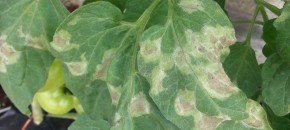
FSMA Informational Meeting October 22, 2013 Rutgers EcoComplex 10:00 a.m. to 12:00 noon Free of Charge Sponsored by: New Jersey Department of Agriculture and New Jersey Farm Burea For more details click the highlighted link.
Continue reading...Rutgers Cooperative Extension

FSMA Informational Meeting October 22, 2013 Rutgers EcoComplex 10:00 a.m. to 12:00 noon Free of Charge Sponsored by: New Jersey Department of Agriculture and New Jersey Farm Burea For more details click the highlighted link.
Continue reading...Basil downy mildew remains active. The weather this time of year is ideal for downy mildew development across many crops. Growers should remain diligent going into the fall with regular scouting and preventative fungicide applications.
Continue reading...Mark VanGessel, Extension Weed Specialist; mjv@udel.edu For no-till fields, a non-selective herbicide needs to be used prior to planting. If grasses or perennial weeds are present, glyphosate is a better choice than paraquat. Fields worked with a vertical tillage implement for residue management still need a non-selective herbicide. These implements are not weed control tools. There […]
Continue reading...Vegetable IPM Report 9-25-13 – Click to View | Download | Print Current Week’s Pest Maps – Available Maps for the week are highlighted European Corn Borer Map Corn Earworm Blacklight Map Corn Earworm Pheromone Map Brown Marmorated Stinkbug Map Vegetable IPM Pest Map Archive
Continue reading...
An isolated case of Late blight has been confirmed in Southern New Jersey on a farm that was growing both field-grown and greenhouse-grown tomatoes. The pathogen originated in an old tomato planting that had been unsprayed since the last pick over 6 weeks ago. Left unscouted, the field developed Late blight and the pathogen moved into the greenhouse operation […]
Continue reading...Late blight has been reported in tomato on an organic farm near Long Valley in Morris County, New Jersey. The cooler weather along with longer periods of leaf wetness lasting into the morning hours this time of year makes conditions ideal for potential Late blight development. As a reminder, once fields or blocks of tomatoes […]
Continue reading...Cooperating Agencies: Rutgers, The State University of New Jersey, U.S. Department of Agriculture, and Boards of County Commissioners. Rutgers Cooperative Extension, a unit of the Rutgers New Jersey Agricultural Experiment Station, is an equal opportunity program provider and employer.
Rutgers University is an equal access/equal opportunity institution. Individuals with disabilities are encouraged to direct suggestions, comments, or complaints concerning any accessibility issues with Rutgers web sites to: accessibility@rutgers.edu or complete the Report Accessibility Barrier or Provide Feedback Form.
Copyright © Rutgers, The State University of New Jersey, an equal opportunity, affirmative action institution
Copyright © 2025 · Generate Child Theme on Genesis Framework · WordPress · Log in